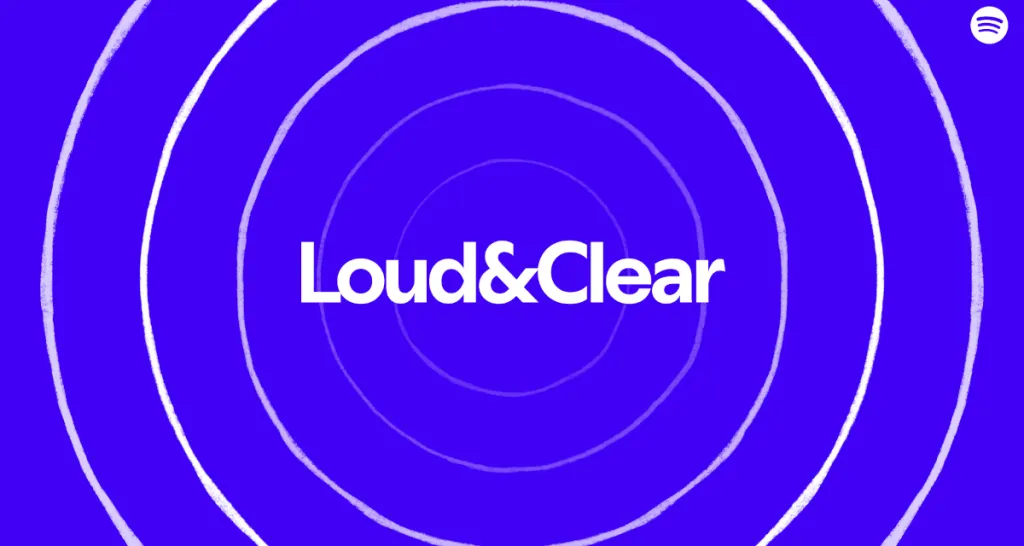Spotify’s Loud & Clear 2024 is here, complete with another multifaceted collection of royalty takeaways. Photo Credit: Spotify
Spotify has released its Loud & Clear breakdown for 2024, when 1,450 artists are said to have generated (but not necessarily pocketed) over $1 million in combined recording and publishing royalties from on-platform streams.
That’s one of the many worthwhile details featured in the report, which, like prior installments, is easy to frame in a negative or optimistic light depending on one’s perspective. All told, Spotify confirmed making a record $10 billion+ in music industry payments for 2024, upping the all-time total to almost $60 billion.
And 2024’s $10 billion, including approximately $5 billion in indie and DIY payments, hiked roughly 10 times from 2014, the platform underscored.
Growing at an even faster clip than these music payments, overall “uploaders,” who might not be artists or even real people, approached an astonishing 12 million last year, Spotify relayed.
Taken one way (and as presented by Spotify), the sum could reflect the comparative accessibility of the streaming world, where, at least in theory, tracks and artists have a far better opportunity to find fans than in the CD era.
Taken another way, the number could attest to the growing difficulties associated with standing out in a vast sea of sound. That’s especially true given the major labels’ inherent streaming advantages and the 1,000 annual streams each Spotify upload must hit in order to begin accruing recording royalties.
At the intersection of those points, just 2.3% of Spotify “uploaders” cracked $1,000 in combined recording and publishing payments from on-platform streams last year, per the data. For the $5,000 category, the percentage came in at less than 1%.
Spotify opted against divulging precisely how many tracks topped 1,000 streams in 2024. But courtesy of different data, we’ve known for some time that a small percentage of uploads touch the threshold.
(The service also continues to insist that it implemented the Universal Music-corralled 1,000-stream minimum to “ensure that as much money as possible reaches the emerging and professional artists that our platform is built to support.” If that was truly the chief focus, though, Spotify could more effectively meet the objective by banning increasingly problematic AI “music” altogether.)
However, Spotify did note that the 100,000th-ranked artist (by on-platform royalties received, that is) enjoyed a material royalties boost between 2014 (“well under $600”) and 2024 (“almost $6,000”).
Like with several other components of Loud & Clear, concrete takeaways here might depend on perspective; technically, Spotify’s 2024 revenue was over 14 times greater than its 2014 counterpart, to name a quick consideration.
An adjacent consideration, albeit one that doesn’t fall on Spotify’s shoulders, is the discrepancy between streaming payouts and the compensation reaching artists themselves.
Even the multi-decade star Snoop Dogg cited paltry Spotify royalty payments as the chief motivation for releasing a new track exclusively via Tune.fm, for instance.
On the publishing side, despite its ongoing bundling controversy and recent direct deals, Spotify said it’d paid a total of close to $4.5 billion in compositional royalties during 2023 and 2024.
Lastly, Spotify wrapped Loud & Clear 2024 by once again attempting to disavow the much-discussed per-stream royalty rate – including by emphasizing the relative value of one in every million on-platform plays last year. Unsurprisingly, this is yet another complicated discussion with more than a few moving parts.
Spotify might not be too concerned with the ultimate per-stream rate, referring to how much artists actually make for each of their plays in an increasingly listening-heavy digital landscape.
But that figure is a major focus for the involved professionals – particularly because the (admittedly bigger) pot of cash ultimately boils down to compensation for a set number of plays and is coinciding with apparent “stream-volume inflation.”
Content shared from www.digitalmusicnews.com.

